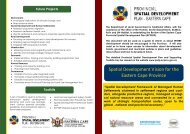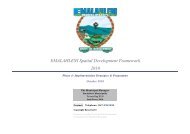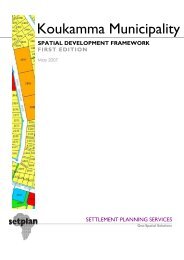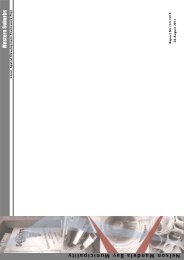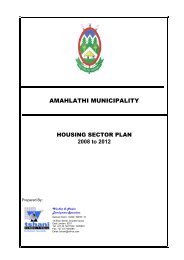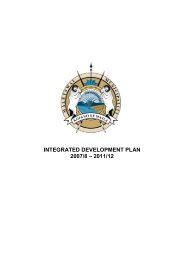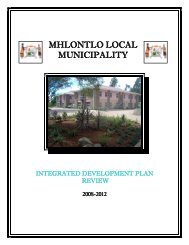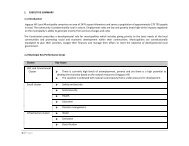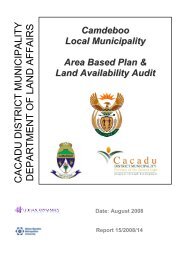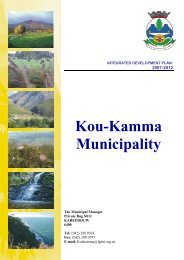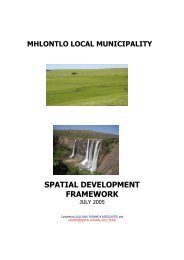intsika yethu local municipality - Provincial Spatial Development plan
intsika yethu local municipality - Provincial Spatial Development plan
intsika yethu local municipality - Provincial Spatial Development plan
You also want an ePaper? Increase the reach of your titles
YUMPU automatically turns print PDFs into web optimized ePapers that Google loves.
5.3 Social Needs Cluster5.3.1 Education levelsIn terms of Stats SA (2001) National Census education IYLM fairs very poorly in terms of education.About 36, 7% of the population has no formal education while 24% have some primary schooling and 7%have completed their primary schooling. About 23% are recorded to have secondary schooling and only9% of the population have completed matric (Std.10 / Grade 12) and Higher education. There are anumber of reasons for the low levels of education in IYLM which include:Parents lack the money to send children to school;Lack of scholar transport (which is critical in providing mobility to scholars to access theireducational institutions) this results in poor scholar attendance and increased dropout rates inmany remote rural areas;Regarding Scholar Transport Assistance, the policy guidelines from the Eastern Cape <strong>Provincial</strong>Department of Education stipulates that public school learners who stay 5km (grade 4-12) as wellas 2,5lm (grade R-3 and physically challenged learners) or more away from nearest andappropriate school should be provided with a subsidized transport to attend school, priorityshould be given to learners in the most disadvantaged communities; andAnother dimension of the problem relates to inadequate School Nutrition program in rural schoolsand farm schools and possible expansion to cater for all needy learners. According to MEC’sSchool Community Co-operative Ilima Programmes (SCCIP), “learners who are hungry do nothave equal access to high quality education, and do not have access to opportunities for equaleducation achievement and will ultimately not have access to further education and employmentopportunities that will change their social and economic circumstances”.It should be acknowledge that in terms of Schedule 4 Part A of the Constitution, education at all levels,excluding tertiary education falls under function areas of concurrent National and <strong>Provincial</strong> legislativecompetence. This implies that all education related issues in the CHDM are dealt with by the Eastern Cape<strong>Provincial</strong> Department of Education (EC-DoE). In recognising that education is a means of promotinggood citizenship as well as preparing our people for needs of a modern economy and democratic society,the government must ensure progressive realisation of universal schooling, improving quality educationand eliminating disparities and inequalities. This requires a major renewal of schooling and educationsystem, by taking the following steps:Work together with educators, learners, parents, school governing bodies and other stakeholders,to make education the priority for all;Making education free and compulsory for all children as well as ensuring increase in no-feeschools particularly in impoverished areas;Introduce a sustainable Early Childhood Education system that spans both public and privatesectors and gives children a head start on numeracy and literacy as well as strengthen support forcrèches and pre-schools in rural villages and urban centres;Improve the quality of schooling, particularly performance in mathematics, science andtechnology and language development. Measures should include provision of incentives formathematics and science teachers;Promote the status of teachers, ensuring the employment of adequate numbers, and improvingtheir remuneration and training, as an important part of the drive to ensure that quality teachingbecomes the norm;66



